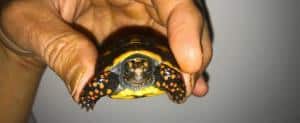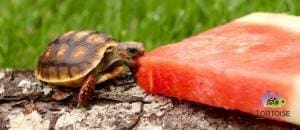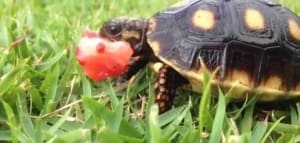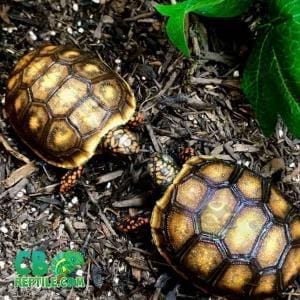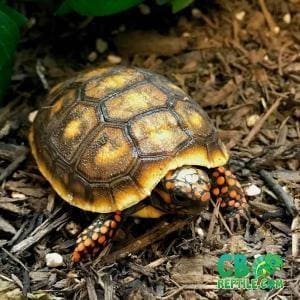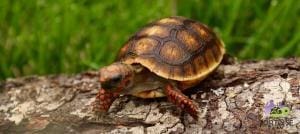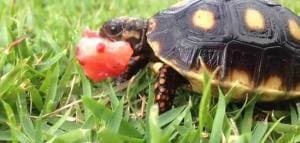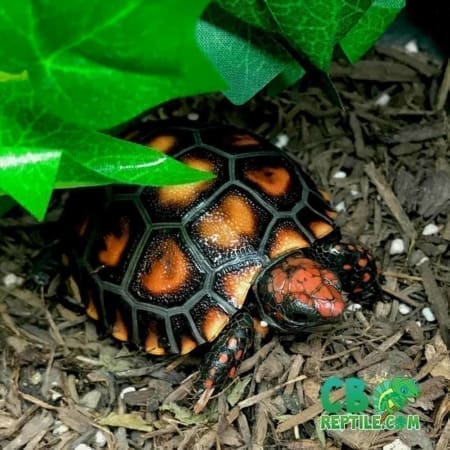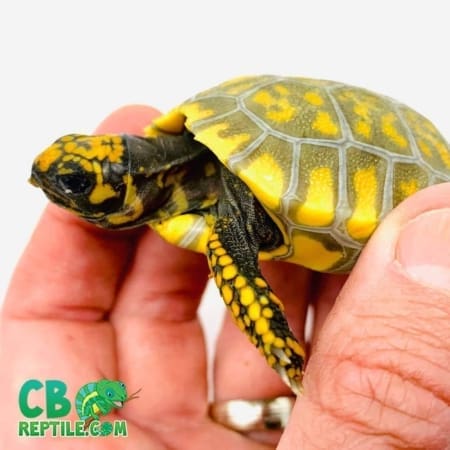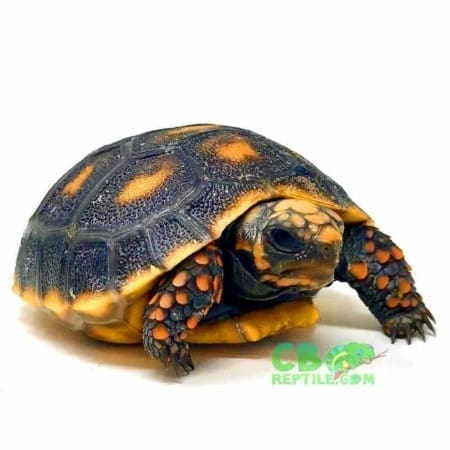Red foot tortoise humidity
Since red footed tortoises are a forest species, they require higher humidity than almost any other species of tortoise. Other relatives of the red foot, including the cherry head tortoise and yellow footed tortoise also have similar humidity requirements. For these reasons, we recommend always purchasing a reptile fogger when you buy your new baby tortoise. Using a fogger every morning that is connected to the same timer as your lighting is best.
Average humidity should be around 75% for red foot tortoises throughout their lifespan. Babies can take even higher humidity as some red footed tortoise breeders recommend humidity as high as 85% for hatchlings. Regardless of age, humidity is always a key component to successfully rasiing any forest tortoise species. We recommend a 75% humidity. Humidity can be acheived by using a reptile fogger, room humidifier, or even just spraying down the habitat walls and substrate multiple times daily. Other options including using a reptile misting system.
Red Foot Tortoise Care sheet
Before purchasing your new Red Foot tortoise for sale, be sure to find a reputable red foot tortoise breeder that works with ONLY CAPTIVE BRED red foot tortoises for sale as well as cherry head red foot tortoise for sale and yellow foot tortoises for sale.
Red Footed tortoises are a moderately sized tortoise normally growing to around a foot long, though larger specimens have been reported. They are a tropical species and their care requirements are quite different to there meditaranian cousins!
Our biolgist has provided detailed care sheets regarding red footed tortoise care that covers the following topics:
- Red footed tortoise care
- red footed tortoise diet
- baby red foot tortoise water
- baby red foot tortoise habitat
- red foot tortoise humidity
- red foot tortoise lifespan
- baby red footed tortoise lighting
- red foot tortoise temperature
- red footed tortoise substrate
- baby and adult red footed tortoise size
- red footed tortoise for sale
- yellow footed tortoise
- baby red footed tortoise
- cherry head tortoise
- all species of baby tortoise
This caresheet is a basic guide to the care of Red Foot Tortoises, though any potential owner would be wise to purchase a more in depth book to ensure they have as much knowledge as possible on their care requirements before purchasing your tortoise.
Red Footed tortoise habitat
Baby Red Foot Tortoises for sale can be kept in a heated habitat with a a temperature range of 82F to 85F with a hot spot at 90F and a 10-15F temperature drop at night. As the baby red footed tortoise develops, it can be introduced to an outside pen but only during the warmer days of the summer. Remember to bring the red foot tortoise inside during the night. Explore the many facets of the red foot tortoise habitat below.
red footed tortoise habitat types
Many different types of red footed tortoise habitats can work just as well. It is really about dialing in the parameters necessary for your baby red foot tortoise to thrive. The first thing to consider is what are you going to use for a habitat? We recommend using something that is large enough that you should not have to change the habitat for at least 2 years. For this reason, provide at least something that is aproxx. 36″x 18″ minimum.
For adult red footed tortoises you should provide at least 6’x3′ per tortoise. As they get older they will reach sizes over 12″ and need room to be able to stroll around their habitat, get exercise and not feeling cramped. It is also normal to have both an indoor and outdoor habitat for your red foot. Using an aquarium for babies for example is fine, you will just need to be mindful of having to give them a larger area as they mature.
Tortoise tables, aquariums, and tortoise house kits
Other options include making a tortoise table, using a zoo med tortoise house, etc. The main concern will be maintaining the high humidity that red foot tortoises require. We recommend using a reptile fogger with all types of habitats to ensure they are getting proper humidity and hydration.
Red foot tortoise lifespan
A long lived species of tropical forest tortoise, the red footed tortoise can live as long as 90 years. Averages are anywhere from 50-90 years, however, in captivity, it is believed they can live even longer if properly cared for. Raising your baby red foot tortoise for sale into a long lived adult is a result of proper care. Proper care includes not only diet, but all habitat parameters that are required. This includes temperatures, humidity, substrate, diet, soaking schedule, etc. It is not uncommon for a baby red footed tortoise to reach the ripe old age of 75 years old, when properly taken care of!
Red Footed tortoise temperature
Like most forest species, red footed tortoise thrives in tropical conditions. This means an ambient temperature of about 86 degrees during the day, that drops to no less than 78 degrees in the evenings. Since red footed tortoises require a higher humidity than most “non forest species”, it is important that evening temperatures do not fall below 78 degrees. If temperatures are too low, your baby red footed tortoise could come down with an upper respiratory infection.
Also, do not forget to always provide a temperature gradient for your tortoise. Temperature gradients for the red foot tortoise should be 95 degrees on the basking spot. Lastly, the coolest spot of the habitat should be around 80 degrees during the day. Nightime temperatures should be in the neighborhood of 80 degrees throughout the enclosure.
Red foot tortoise UVB lighting
Whilst the tortoise is maintained in a Vivarium, it is vital that it receives the correct UVB lighting to aid vitamin D3 production and utilisation. In their native habitat little light reaches the forest floor so 5% UVB should be used. In the summer, when the temperature permits, the tortoises can be kept outside to benefit from natural sunlight. It is imperative that if you put your tortoise out in natural sunlight that you also provide it with a shaded area. This can be done either with a hide or with clumps of hay or grass.
Being a rainforest species, Red Foots require a rather high humidity and so humidity levels in the vivarium should be maintained at around 70% – 90%. Too low a humidity can results in respiratory problems and inflammation around the eyes.
Red footed tortoise diet
Your baby or adult red footed tortoise will thrive on a diet consisting largely of fruit and leafy vegetables. Tomato, melon a grapes are suitable as well as carrot, and this can be mixed with various leafy green vegetables. Include dark leafy greens like Collard, Mustard greens, Kale, Greens, Brussell Tops, Parsley and Watercress.
Foods to stay away from
Do not feed your tortoise Iceberg or Round Lettuce although you can provide “Mixed Lettuce” sold in supermarkets that consist of Chinese Lettuce, Raddico, etc. Lettuce should be viewed as once a week feed as it contains high amounts of water and not as much goodness as the other foods mentioned.
Red foot tortoises have a unique varied diet
Red Foot Tortoises are opportunistic feeders and in the wild they will also eat meat if it is available and so once a fortnight it is advisable to offer a low fat cat food to your tortoise to provide it with the animal proteins it would have in its natural diet.
Because of the higher protein diet, it is even more important for fresh water to be available at all times and should be provided in a shallow dish, but deep enough so that your tortoise can submerge both its nose and mouth to drink. Be sure your Red Foot Tortoise can climb in and out of the bowl with ease.
We primarily feed mazuri tortoise chow along with collard greens, mustard greens, papaya, green squash, yellow squash, shaved carrots, endive, mango and strawberries as a treat.
Cleaning the red footed tortoise habitat
Check the red foot tortoise habitat a few times a week for poop, and spot clean by removing. Also, always rinse the food adn water dishes out at least every other day, of not daily. Always remember to place your Red Foot Tortoise in an escape proof container while cleaning its habtiat if you cannot leave it in the habitat while cleaning.
Red foot tortoise substrate
Substrate for your red footed tortoise habitat can be many things. First look at the depth… We try to provide at least 4″ of substrate depth. By providing this depth of substrate, it allows your baby tortoise to burrow into it’s own desired micro-climate. This means there is a high humidity based climate that is beneath the top layer of substrate. Spraying down the soil and walls of the habitat every day, as well as using a reptile fogger helps keep humidity high at 80%. Micro climates are a key to successfullty raising a baby red foot tortoise, cherry head tortoise for sale or yellow foot tortoise to adulthood.
types of substrate for red foot tortoises
Types of substrate include potting mix, potting soil, play sand, etc. We recommend using 50/50 play sand to potting mix and using a top layer of forest floor cypress mulch to complete your substrate. Other options include coco coir, hay, dried grasses, and other commercial tortoise substrates.
Bioactive red foot tortoise habitats
If you decide to go “bioactive” wirth your substrate and setup, cleaning is needed much less often. When you setup a bio active setup, it is more of a self sufficient closed system, that maintains itself. Using isopods as well as red worms, and other different insects can create a very nice, self contained bio active red footed tortoise habitat.
Red foot tortoise size
Considered a medium sized tortoise, the red footed tortoise reaches sizes of up to 15″. Most red foots will grow to around 12-14″. There are also giant amazon basin red foot subspecies that reach over 16″. This is the same for the yellow footed tortoise. The cherry head tortoise will be the smaller of the group of 3, only reaching 10-12″ on average.
Depending on the exact locale of the red footed tortoise, size can be anywhere from 10-16″ with most falling closer to 13-14″. When you consider the adult size of the red footed tortoise, think about the overall habitat required 0nce mature. For this reason, you may want to build a larger habitat from day one.
baby red footed tortoise care
Every morning we recommend that you soak your baby red footed tortoise in a dish, clean new cat litter tray or shallow bowl. Never use cold tap water as this will be a shock to them and cause them to not drink. Soak your tortoise approximately 10-15 minutes and then offer them fresh food by placing them on top of their salad. If the babay red foot tortoise is sluggish or looking tired in opening its eyes, they may be dry and need a soak.
When soaking your tortoise, if the water is warm, they will poop quite a bit. This is good, not bad as it helps keep the enclosure clean. For this reason, we recommend taking them out of the soaking dish if/once they have soiled the water.
-
 Rated 5.00 out of 5
Rated 5.00 out of 5Cherry Head Tortoise
$299.95 – $2,899.95 Sale!Select options This product has multiple variants. The options may be chosen on the product page -

Yellow foot tortoise
$299.00 – $1,499.00 Sale!Select options This product has multiple variants. The options may be chosen on the product page -
 Rated 5.00 out of 5
Rated 5.00 out of 5Red Footed tortoise for sale
$249.95 – $1,199.00 Sale!Select options This product has multiple variants. The options may be chosen on the product page


